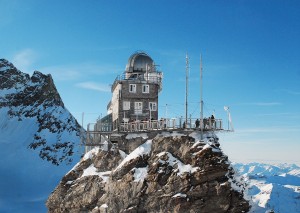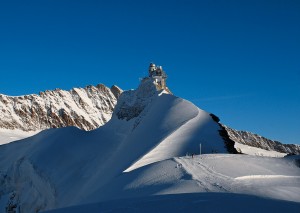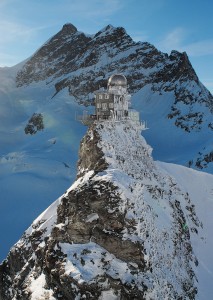Summary
- Coordinates: 53°20′ N, 9°54′ W
- Height: 5 m inlet
- Base level: 3580m ASL
- Country: Switzerland
- InGOS observations: CH4, N2O, SF6, H2, 222Rn, halocarbons
- Responsible partner: Swiss Federal Laboratories for Materials Science and Technology (EMPA)
- Responsible PI: Stefan Reimann (stefan.reimann@empa.ch)
- TNA access: access request page
- Website: http://www.ifjungo.ch
General
Jungfraujoch is a high-Alpine station (3580 m asl) located in the centre of Western Europe. It is a station in the Global Atmosphere Watch (GAW) program of the World Meteorological Organization (WMO) and it is included in the Swiss National Air Pollution Monitoring Network (NABEL). During extended periods, the Jungfraujoch is decoupled from the tropospheric boundary layer below and can be used as a background site. On the other hand, transport of polluted boundary layer air to the height of the Jungfraujoch occurs periodically because of meteorological transport connected with the passage of fronts, foehn winds, or thermally driven convection during anticyclonic periods in summer. A recent modelling study assessing the representativeness of monitoring sites in Europe based on backward Lagrangian Particle Dispersion Modelling categorized Jungfraujoch as ‘mostly remote‘. It is therefore very much used to study transport processes between the boundary layer and the unpolluted troposphere.
The High Alpine Station Jungfraujoch (3580 m above sea level) is situated in the northern part of the Swiss Alps and belongs to the first topographical barrier for the frequent westerly winds in central Europe. Its location is relatively remote, with the nearest villages more than 8 km in horizontally and 2.5 km in vertically distance and is only weakly influenced by local anthropogenic sources. Therefore, it can be used to monitor pollutant emissions from a wider area surrounding the Alps. The emission source regions, which have a detectable impact on the measurements at Jungfraujoch, have been investigated by Reimann et al. (2008). It was concluded that emissions from an integrated area in central Europe including Switzerland, northern Italy, France, southern and western Germany, the Benelux countries, and to limited extent northeastern parts of Spain could be observed at Jungfraujoch.
Infrastructure and facilities
 Within the Swiss National Air Pollution Monitoring Network (NABEL) the whole suite of non-CO2 greenhouse gases are measured by Empa. Measurements of CH4 and N2O are performed continuously since 2005 by using a GC-FID and a GC-ECD, respectively. In the last year CH4 measurements have been upgraded by a Cavity Ringdown Spectrometer (CRDS) and N2O measurements by Quantum Cascade Laser Spectrometry (QCL) will be added in 2014/15. Furthermore, CO2 and CO2 isotopes (QCL) are measured continuously by the University of Bern and Empa, respectively (Uglietti et el., 2008; Tuzson et al. 2010). Around 50 halocarbons are measured at Jungfraujoch with the MEDUSA system (Reimann et al., 2008; Vollmer et al., 2011). These measurements are part of the global AGAGE measurement network and they are used for both regional and global emission verification (Brunner et al., 2012; Keller et al., 2011, 2012; Vollmer et al., 2012; Yao et al., 2012a,b; In addition, vertical column measurements of some of the halogenated greenhouse gases (SF6, CF4, CFC-12, HCFC-22) and other substances by Fourier Transform Infrared Spectroscopy (FTIR) related to global change have been performed routinely at the Jungfraujoch for many years (Zander et al., 2008; Mahieu et al., 2014). The actual research plan includes 16 long-term projects of 21 teams being part of European and global networks. Advanced measuring techniques are being used for environmental research. Most of the research programs, but in particular the long-term investigation of the physics and chemistry of the Earth’s atmosphere, are expected to contribute significantly to more than 25 internationally and nationally coordinated research initiatives.
Within the Swiss National Air Pollution Monitoring Network (NABEL) the whole suite of non-CO2 greenhouse gases are measured by Empa. Measurements of CH4 and N2O are performed continuously since 2005 by using a GC-FID and a GC-ECD, respectively. In the last year CH4 measurements have been upgraded by a Cavity Ringdown Spectrometer (CRDS) and N2O measurements by Quantum Cascade Laser Spectrometry (QCL) will be added in 2014/15. Furthermore, CO2 and CO2 isotopes (QCL) are measured continuously by the University of Bern and Empa, respectively (Uglietti et el., 2008; Tuzson et al. 2010). Around 50 halocarbons are measured at Jungfraujoch with the MEDUSA system (Reimann et al., 2008; Vollmer et al., 2011). These measurements are part of the global AGAGE measurement network and they are used for both regional and global emission verification (Brunner et al., 2012; Keller et al., 2011, 2012; Vollmer et al., 2012; Yao et al., 2012a,b; In addition, vertical column measurements of some of the halogenated greenhouse gases (SF6, CF4, CFC-12, HCFC-22) and other substances by Fourier Transform Infrared Spectroscopy (FTIR) related to global change have been performed routinely at the Jungfraujoch for many years (Zander et al., 2008; Mahieu et al., 2014). The actual research plan includes 16 long-term projects of 21 teams being part of European and global networks. Advanced measuring techniques are being used for environmental research. Most of the research programs, but in particular the long-term investigation of the physics and chemistry of the Earth’s atmosphere, are expected to contribute significantly to more than 25 internationally and nationally coordinated research initiatives.
- GAW Global Atmosphere Watch
- AGAGE Advanced Atmospheric Gases Experiment
- CHARM Swiss Atmospheric Radiation Monitoring Program
- NDACC Network for the Detection of Atmospheric Composition Change
- UNEP United Nations Environment Programme
- ANETZ automatic measuring network of MeteoSwiss
- RADAIR Swiss network for the survey of radioactivity in air
- NABEL Swiss National Air Pollution Network
- ACCENT-plus European network on Atmospheric Composition Change
- IMECC Infrastructure for Measurements of the European Carbon Cycle
- ASRB Alpine Surface Radiation Budget Network
References for Jungfraujoch observations
- Brunner, D., S. Henne, C.A. Keller, S. Reimann, M.K. Vollmer, S. O’Doherty, M. Maione, An extended Kalman-filter for regional scale inverse emission estimation, Atmos. Chem. Phys., 12, 3455–3478, 2012.
- Keller, C.A., D. Brunner, S. Henne, M.K. Vollmer, S. O’Doherty, and S. Reimann, Evidence for under‐reported western European emissions of the potent greenhouse gas HFC‐23, Geophys. Res. Lett., 38, L15808, doi:10.1029/2011GL047976, 2011.
- Keller, C.A., M. Hill, M.K. Vollmer, S. Henne, D- Brunner, S. Reimann, S. O’Doherty, J. Arduini, M. Maione, Z. Ferenczi, L. Haszpra, A.J. Manning, T. Peter, European emissions of halogenated greenhouse gases inferred from atmospheric measurements, Environ. Sci. Technol., 46 (1), 217–225, 2012.
- Mahieu, E., R. Zander, G.C. Toon, M.K. Vollmer, S. Reimann, J. Mühle, W. Bader, B. Bovy, B. Lejeune, C. Servais, P. Demoulin, G. Roland, P.F. Bernath, C.D. Boone, K.A. Walker, and P. Duchatelet, Spectrometric monitoring of atmospheric carbon tetrafluoride (CF4) above the Jungfraujoch station since 1989: evidence of its continued increase but at a slowing rate, Atmos. Meas. Techn.,7, 333–344,2014.
- Reimann, S., M.K. Vollmer, D. Folini, M. Steinbacher, M. Hill, B. Buchmann, R. Zander, and E. Mahieu, Observations of long-lived anthropogenic halocarbons at the high-alpine site of Jungfraujoch (Switzerland) for assessment of trends and European sources, Sci. Tot. Environ., 391, 224–231, 2008.
- Tuzson, B., Henne, S., Brunner, D., Steinbacher, M., Mohn, J., Buchmann, B. and Emmenegger, L., Continuous isotopic composition measurements of tropospheric CO2 at Jungfraujoch (3580ma.s.l.), Switzerland: real-time observation of regional pollution events. Atmos. Chem. Phys. Discuss. 10: 24563–24593, 2010.
- Uglietti C., M. C. Leuenberger, D. Brunner,. European source and sink areas of CO2 retrieved from Lagrangian transport model interpretation of combined O2 and CO2 measurements at the high alpine research station Jungfraujoch. Atmospheric Chemistry and Physics, 11, 8017-8036, 2011.
- Vollmer, M.K., B.R. Miller, M. Rigby, S. Reimann, J. Mühle, P. B. Krummel, S. O’Doherty, J. Kim, T.S. Rhee, R.F. Weiss, P.J. Fraser, P.G. Simmonds, P.K. Salameh, C.M. Harth, R.H.J. Wang, L.P. Steele, D. Young, C.R. Lunder, O. Hermansen, D. Ivy, T. Arnold, N. Schmidbauer, K-R. Kim, B.R. Greally, M. Hill, M. Leist, A. Wenger, R.G. Prinn, Atmospheric histories and global emissions of the anthropogenic hydrofluorocarbons (HFCs) HFC-365mfc, HFC-245fa, HFC-227ea, and HFC-236fa, J. Geophys. Res., 116 (D8), D08304, 2011.
- Yao, B., M.K. Vollmer, L. Zhou, S. Henne, S. Reimann, P. Li, A. Wenger, M. Hill, In-situ measurements of atmospheric hydrofluorocarbons (HFCs) and perfluorocarbons (PFCs) at the Shangdianzi regional background station, China, Atmos. Chem. Phys., 12, 10181-10193, 2012a.
- Yao, B, M.K. Vollmer, L. Xia, L. Zhou, P.G. Simmonds, F. Stordal, M. Maione, S. Reimann, S. O’Doherty, A study of four-year HCFC-22 and HCFC-142b in-situ measurements at the Shangdianzi regional background station in China, Atmos. Environ., 63, 43-49, 2012b.
